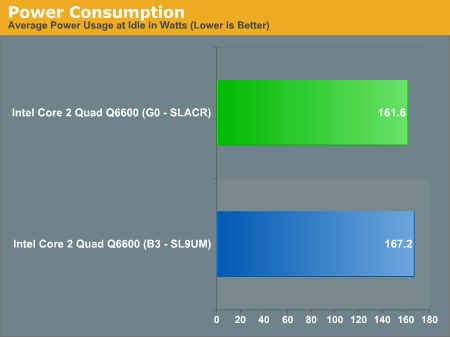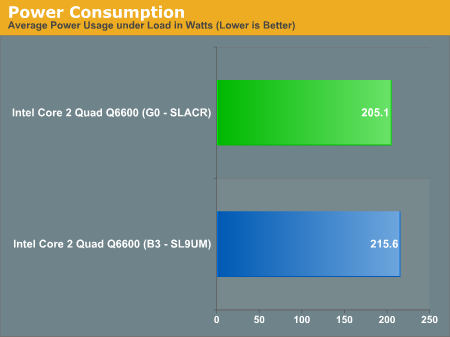Intel Core 2 Q6600 G0 Stepping: Cheap Quad Core Just Got Better
by Anand Lal Shimpi on August 16, 2007 11:53 AM EST- Posted in
- CPUs
Power Consumption: A Cooler SLACR?
We know from Intel's own documentation that G0 cores draw less power at idle than their B3 predecessors. In the C1E power state the G0 Q6600 is supposed to dissipate 24W compared to 50W of its B3 predecessor. On paper the savings are dramatic, but keep in mind that a processor doesn't spend all of its time in C1E - so how does G0 stack up in the real world?
In order to find out we looked at total system power consumption in two situations: idle and when running our Windows Media Encoder 9 test, a fairly CPU intensive benchmark. We measured average power consumption over the course of the test.

At idle, G0 draws 5.6 fewer watts, a reduction of just over 3%. Nothing terribly impressive, but let's look at results under load:

The G0 advantage grows to 10.5W under load, or an advantage of just under 5%. This alone isn't reason to upgrade, but lower power consumption is far from a bad thing. Does the new G0 stepping translate into better overclocking potential given its lower power consumption?










34 Comments
View All Comments
Anand Lal Shimpi - Thursday, August 16, 2007 - link
Both chips used the same VID surprisingly enough, that's part of what made this test so easy. I have seen differing results at 8x vs. 9x multipliers, but it didn't seem to make a huge difference when I tried it with these chips. I'll keep playing around with them though.Take care,
Anand
Kougar - Thursday, August 16, 2007 - link
Hi Anand!Could you please mention what the VID was, if it was identical between chips then it sounds like it was over 1.3v?
You probably had already seen http://forums.anandtech.com/messageview.aspx?catid...">http://forums.anandtech.com/messageview.aspx?catid... but I thought it was interesting that some of the VIDs are so low. My own sample is also 1.200v and seems to OC well enough, a partially corrupted OS notwithstanding anyway.
My Pentium M barely operates stable at 2.13GHz using 1.18v and it's obviously single core, so it just sounds odd that a 2.4Ghz Quadcore could have an even lower VID than 1.18v even with the 90nm -> 65nm difference. Maybe that is just me though!
Anand Lal Shimpi - Thursday, August 16, 2007 - link
It was 1.20V on both chips I believe.Take care,
Anand
Grit - Thursday, August 16, 2007 - link
Woot!